Lion Rock is the most iconic peak in Hong Kong.
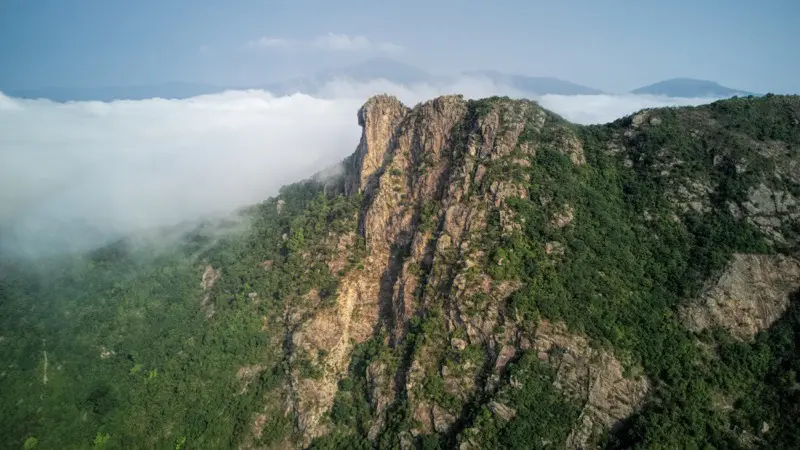
Though at 495 metres high, Lion Rock is far from Hong Kong’s tallest hill, it is the most iconic peak in the territory. This is partly because of the distinctive resting lion profile of the craggy upper slopes, as viewed from places including parts of Kowloon. Also, Lion Rock has become associated with the can-do character of Hong Kong people.
This linkage began in the 1970s, with a television series on the lives of working class people, many of whom had lived or still lived in squatter settlements on slopes below Lion Rock. Later, the Lion Rock Spirit was cited by businessmen and politicians. And during the Occupy Movement in October 2014, a band of intrepid activists hung a giant yellow banner on the rock, with black characters proclaiming, “I want real universal suffrage”.
While most people only see Lion Rock from afar, it’s a prime site for rock climbers, and there are a couple of trails to the top for hikers. Though reaching the summit takes some effort, the rewards are spectacular views over city and countryside.
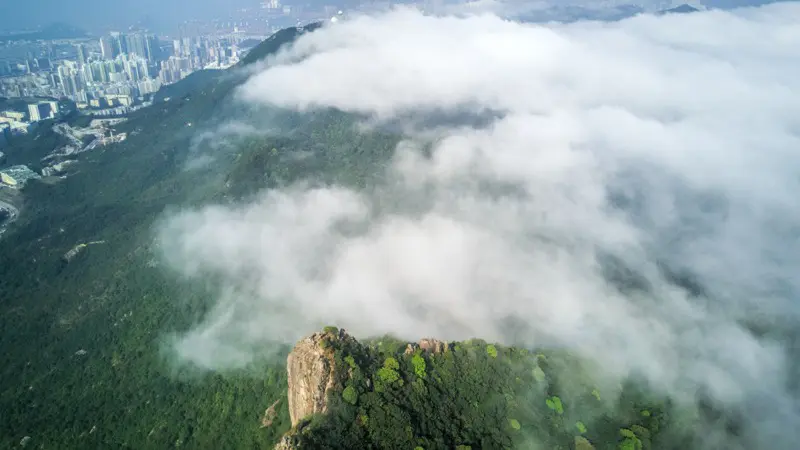
Park Hike
Lion Rock is at the heart of the country park bearing its name, and a web of trails makes for a variety of possible outings. While you could start an ascent from close to sea level, a road up the Kowloon Hills makes it possible to instead set off from around half way up, at Sha Tin Pass.
From here, head up section 5 of the Maclehose Trail, which first aims for Unicorn Ridge. North Kowloon high-rises are close by, and even if there’s thick fog it can’t muffle the continual hum of city traffic below.
At the ridge, the trail dips gently, curling northwards, then winds through woodland towards the south slopes of Lion Rock. The city hum fades, laughingthrushes may be among forest birds singing close by, typically unseen amidst the dense cover.
The Gin Drinkers Line – a series of defensive positions, was built across these hills in the 1930s, to guard against invasion by Japanese forces that were fighting in mainland China. Notions the holdout might last six months were swiftly proven fanciful in December 1941, when defending troops were forced to abandon the line within just two days.
Some relics are scattered along the Maclehose Trail here, and one – a marker stone – indicates one of the issues with the Gin Drinkers Line. Like some other markers, it shows distances to nearby positions, and was later spotted by a British soldier as he escaped being a prisoner of war, and noted he was bewildered that such information was readily available for the enemy.
Where the Going Gets Tough
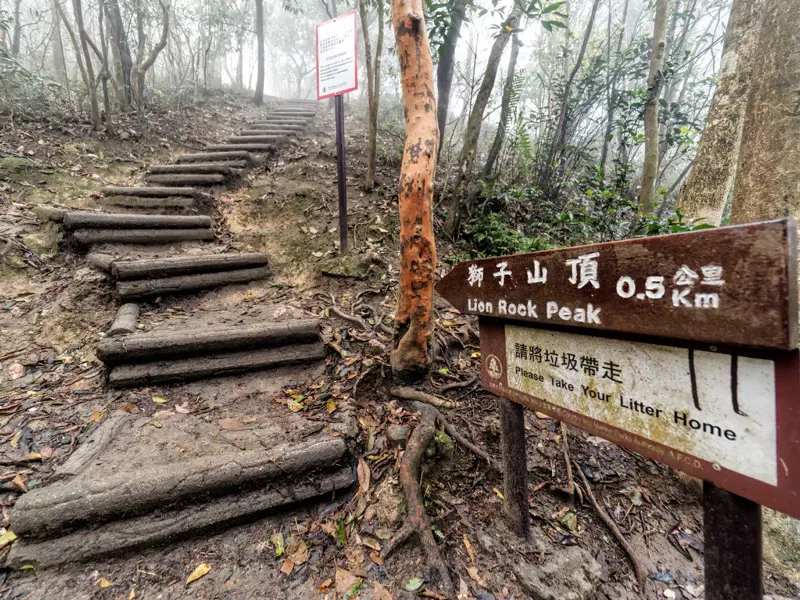
There’s a trail junction, with a wooden sign indicating Lion Rock Peak is 0.5km away. That’s so little distance, and though there are some steps going up, the slope here is gentle. So it should be easy, right?
Well, not exactly. A sign warns, “This section of trail is very difficult and suitable only for experienced and well-equipped hikers.” Which is not quite so doom laden as pronouncing, “Abandon hope, all ye who enter”, but does indicate the climb will be challenging for regular folk.
If you’re deterred by the challenge – and for sure if the weather has deteriorated, you can turn back or simply continue along the Maclehose Trail. Otherwise, onwards and upwards!
On the Rock
The trail indeed becomes steep.
At last, the woodland thins, and you can look back across the Sha Tin valley. Just maybe, this is one of the rare mornings when the route so far has been through morning fog, but now there are suddenly clear skies overhead, and you can look back over a sea of cloud, above which rises Tai Mo Shan on the north horizon. If so, you’re in luck, though Lion Rock is a marvellous vantage in almost any weather.
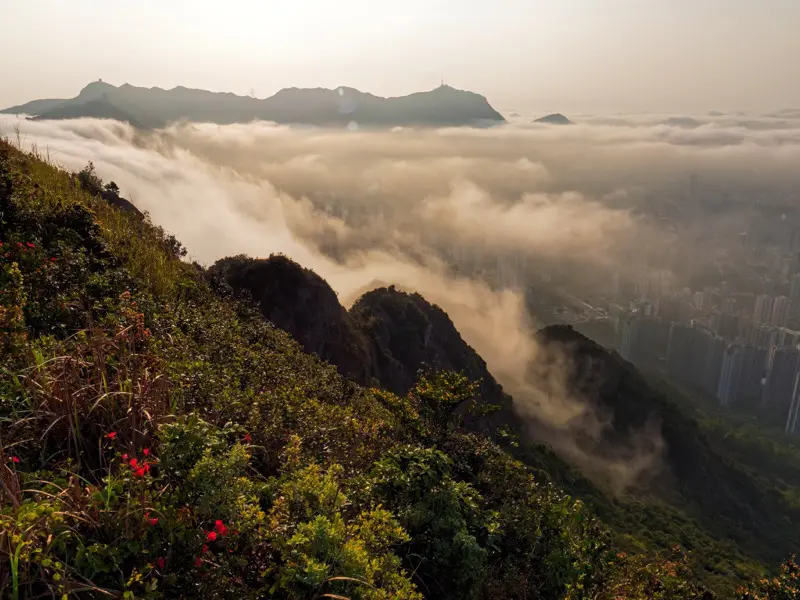
Just a few more metres, and you’re atop a ridge, with almost sheer slopes dropping to the fringes of Kowloon; Hong Kong Island lies to the south. With the city arrayed below, contrasting with the wild yet tranquil hilltop, this is an exhilarating place.
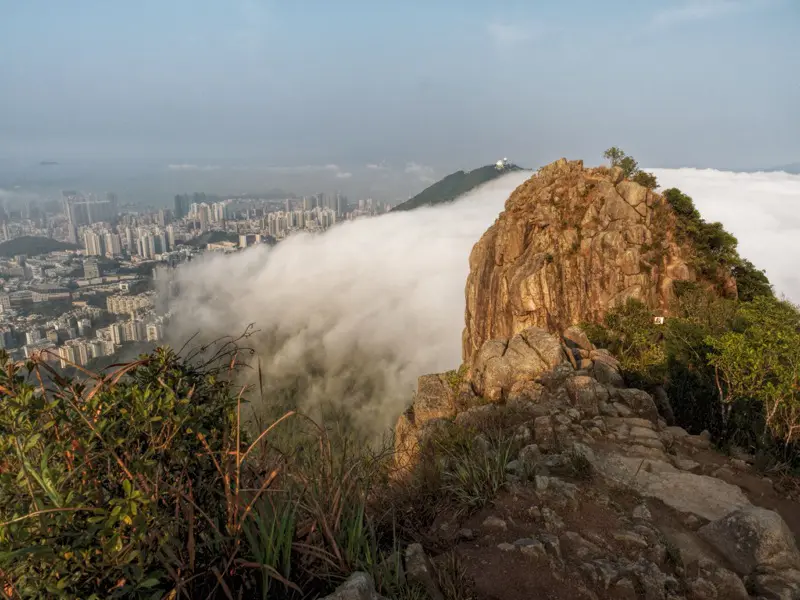
A rough track takes you westwards, dipping to a trail junction right above the main granite cliff. From here, you could scramble up to the head of the lion – but take great care; as recently as May last year a hiker fell to his death here. [maybe trying to take an over-daring photo… ]
From the junction below the lion’s head, you can follow another rough trail downwards. There’s some steep scrambling between boulders, until the trail eases a little, and you rejoin the Maclehose Trail.
Morning Walkers’ Rendezvous
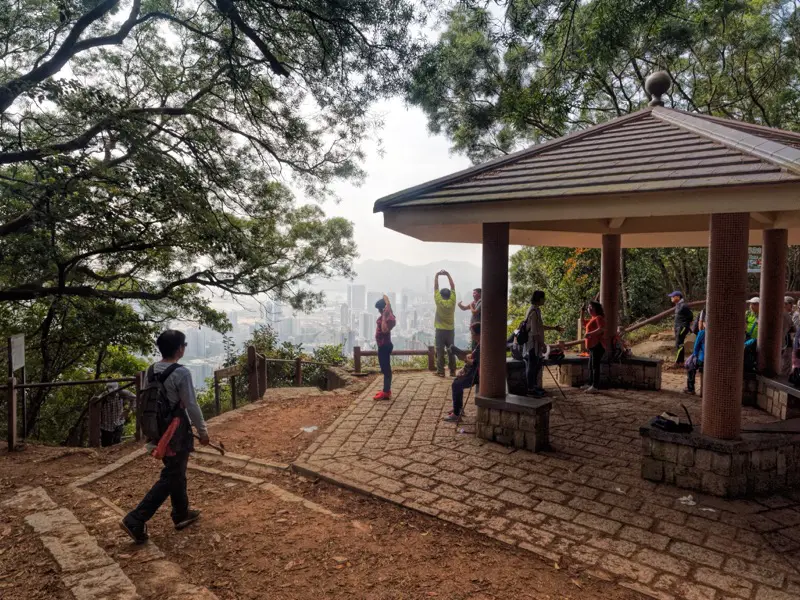
Walk westwards, and soon the Maclehose Trail arrives at a pavilion overlooking Kowloon. Some energetic residents of nearby areas like to walk up to here in the mornings, maybe then working stretching and jumping on the spot for extra exercise, or just sitting for a chat.
You might leave the area by taking a trail as these walkers have followed. Or keep going along the Maclehose Trail, which climbs Beacon Hill, then drops and passes Eagle’s Nest before arriving at Tai Po Road.
Another possibility takes you to another renowned local rock formation – Amah Rock. You can find it readily by following a side trail down through the woods, then making for a low hilltop.
Right Here Waiting … and Waiting

Are you sitting comfortably? Then I’ll begin, with the legend of how Amah Rock was formed:
A local fisherman went to sea, but, alas, was drowned. Not knowing his fate, his wife climbed to this hilltop each day, carrying her son, to await his return. Eventually, she and her son were turned to rock by the kindly Goddess of the Sea, allowing their spirits to reunite with her husband.
Moving on, here’s the scientific explanation:
Granite cracks as it cools, and as the granite here eroded and weathered, much of it fell away along the cracks, leaving a 15m high column of granite blocks in a structure that geologists call a tor.
From a distance, Amah Rock can look slender, with a couple of shapes on top that somewhat resemble the wife’s head along with the son she carries. Up close, it seems squatter, the granite surface rough and orangish, as weathering continues – along with the wife’s vigil.
Getting there – and away
While you can walk to Sha Tin Pass from Wong Tai Sin and other nearby places, it’s far easier to take a taxi. From Amah Rock, it’s a short walk down to a catchwater, from where a nature trail leads to Lion Rock Tunnel Road – arriving close to bus stops and near Tai Wai East Rail Station.
